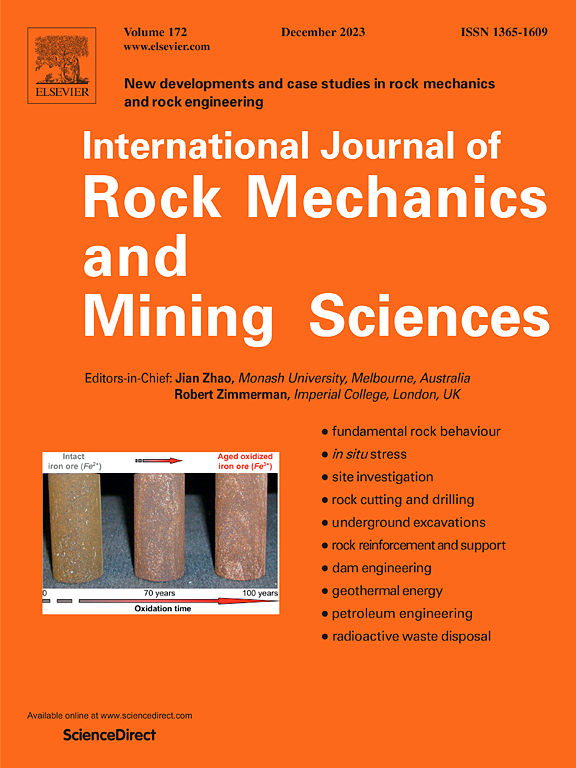Asymmetric failure mechanisms of anisotropic shale under direct shear
IF 7
1区 工程技术
Q1 ENGINEERING, GEOLOGICAL
International Journal of Rock Mechanics and Mining Sciences
Pub Date : 2024-11-01
DOI:10.1016/j.ijrmms.2024.105941
引用次数: 0
Abstract
This study performed mechanical tests and monitored acoustic emissions (AE) in shale samples with six bedding layer orientations (β = 0°, 30°, 60°, 90°, 120°, and 150°) to investigate the progressive damage mechanisms under direct shear. The results revealed that the peak shear load (Pcr), crack initiation threshold (Pci), crack damage threshold (Pcd), and cumulative AE count exhibited an approximate M-shaped trend as the bedding angle increased. The Pci, Pcd, and Pcr values were minimal for shale specimens with β = 0°, Pcd and Pcr were maximal at β = 150° (followed by β = 60°), and Pci reached the maximum at β = 60°. Thus, shale exhibits complex and asymmetric mechanical behavior under direct shear, a phenomenon seldom documented. The three-dimensional spatiotemporal evolution of the AE, evolution of b-values, peak frequency distribution, and the rise angle-average frequency (RA-AF) indicated that the microscale mechanism governing the asymmetric progressive failure of anisotropic shale under direct shear involved significant asymmetry in the formation type and scales of cracks. The AE characteristics of anisotropic shale were analyzed using multifractal theory. The width of the multifractal spectrum, Δθ, accurately reflected the anisotropic characteristics of the AE time series. Moreover, the variation in the fractal dimension, Δf, indicated that the different probabilities of microcracks with high AE energy are the fundamental cause of the shale's asymmetric failure.
各向异性页岩在直接剪切作用下的非对称破坏机制
本研究对六种垫层方向(β = 0°、30°、60°、90°、120°和 150°)的页岩样品进行了力学测试和声发射(AE)监测,以研究直接剪切作用下的渐进破坏机制。结果表明,峰值剪切载荷(Pcr)、裂纹起始阈值(Pci)、裂纹损伤阈值(Pcd)和累积 AE 计数随着垫层角度的增加呈现近似 M 型的趋势。在 β = 0° 时,页岩试样的 Pci、Pcd 和 Pcr 值最小;在 β = 150° 时,Pcd 和 Pcr 最大(其次是 β = 60°);在 β = 60° 时,Pci 达到最大值。因此,页岩在直接剪切作用下表现出复杂的非对称力学行为,这种现象很少见诸文献。AE 的三维时空演变、b 值演变、峰值频率分布和上升角度-平均频率(RA-AF)表明,各向异性页岩在直接剪切作用下的非对称渐进破坏的微观机制涉及裂缝形成类型和规模的显著非对称性。利用多分形理论分析了各向异性页岩的 AE 特性。多分形谱宽度 Δθ 准确地反映了 AE 时间序列的各向异性特征。此外,分形维数 Δf 的变化表明,高 AE 能量产生微裂缝的不同概率是页岩非对称破坏的根本原因。
本文章由计算机程序翻译,如有差异,请以英文原文为准。
求助全文
约1分钟内获得全文
求助全文
来源期刊
CiteScore
14.00
自引率
5.60%
发文量
196
审稿时长
18 weeks
期刊介绍:
The International Journal of Rock Mechanics and Mining Sciences focuses on original research, new developments, site measurements, and case studies within the fields of rock mechanics and rock engineering. Serving as an international platform, it showcases high-quality papers addressing rock mechanics and the application of its principles and techniques in mining and civil engineering projects situated on or within rock masses. These projects encompass a wide range, including slopes, open-pit mines, quarries, shafts, tunnels, caverns, underground mines, metro systems, dams, hydro-electric stations, geothermal energy, petroleum engineering, and radioactive waste disposal. The journal welcomes submissions on various topics, with particular interest in theoretical advancements, analytical and numerical methods, rock testing, site investigation, and case studies.

 求助内容:
求助内容: 应助结果提醒方式:
应助结果提醒方式:


